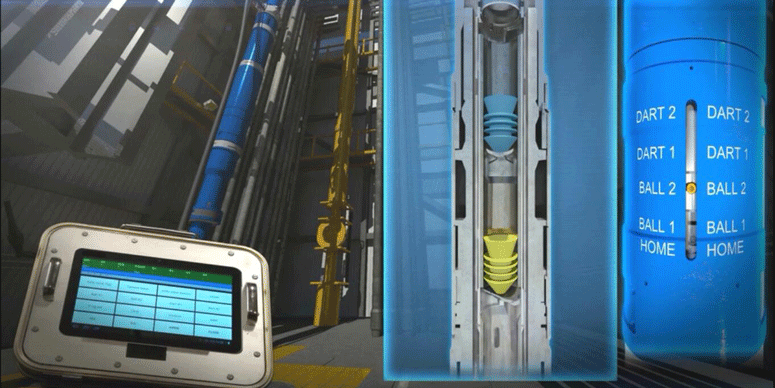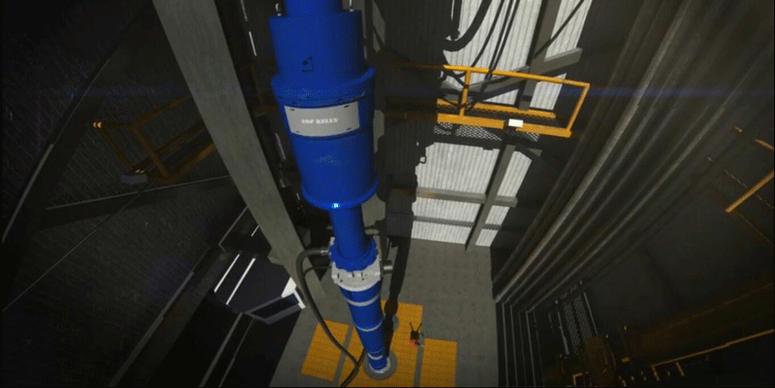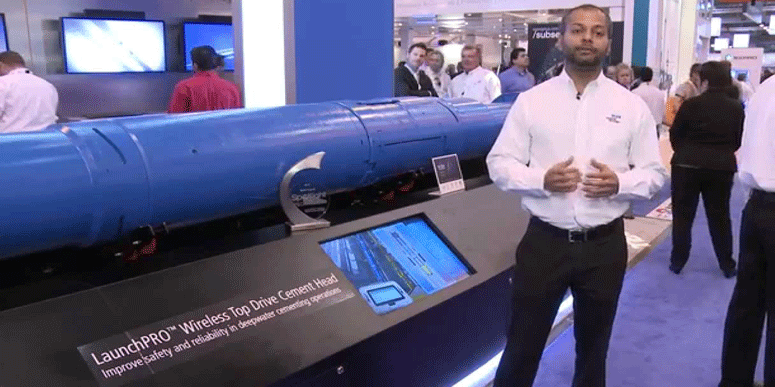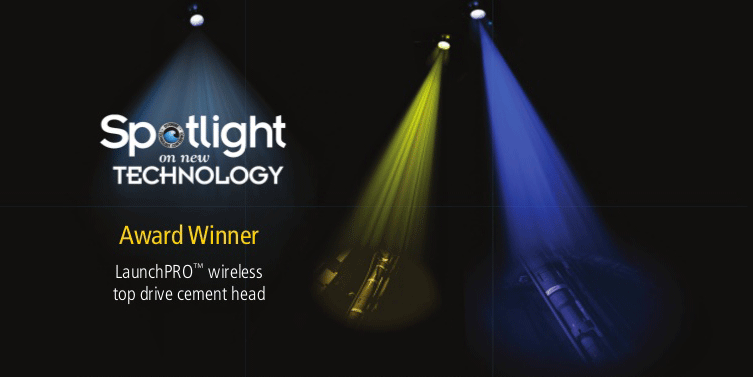The state-of-the-art Baker Hughes LaunchPRO™ wireless top drive (TD) cement head launches plugs, balls, and darts by remote control when cementing extremely heavy subsea long strings and long, heavy liners. The cement head is compatible with the Baker Hughes Seahawk family of reliable, high-performance offshore cementing equipment, and it features an industry leading 2,500,000 lb (1 133 981 kg) load capacity, exceeding the capacity of today’s strongest API drill pipe connection. Its advanced features meet the demands of today’s longer, deeper subsea completions.
Introduction
The LaunchPRO TD cement head’s wireless operation reduces health, safety, and environment (HSE) risk by eliminating the need for manual intervention. After the cement head is in place, all functions can be performed wirelessly by means of a handheld remote control. This keeps rig personnel out of the red zone, and reduces the time it takes to launch plugs, balls, and darts. For added reliability, it also features manual override for all functions.
The tool’s streamlined design greatly reduces the risk of external component damage that could result in nonproductive time (NPT). The head’s pneumatic operation is powered by rig air through a single pneumatic hose connected near the cementing line inlet. This air line can be tethered to the cementing line to reduce the risk of damage during cementing. The cement head also features a hydraulically balanced internal cementing valve that operates independently from launching functions and allows for pressure testing with little to no intervention.
Plugs and darts are launched wirelessly using positive fluid displacement rather than mechanical springs. Before plugs and darts are launched, a flow-around cage prevents potential damage that could be caused by having the plugs and darts directly in the flow path. When it is time to launch, fluid is diverted above the plugs or darts and forces them down the drillpipe. This increases reliability and saves rig time with launch-onthe-fly capability.
Internal sensors provide real-time launch sequence position to the operator panel, and a dart launch indicator system provides visual and audible confirmation of a successful plug or dart launch. The system automatically resets and provides notice of each plug or dart that passes.
A pressure transducer provides real-time data to the cementing operator through an operator interface unit, so adjustments can be made while pressure is monitored. This helps ensure a reliable cement job, and the transducer provides a single source of recorded pressure data whether the job is displaced with the cementing unit or the rig mud pumps.
The cement head’s unique, customized lift basket enables easy loading of balls and darts onsite, and includes a pneumatic trolley system that reduces the labor required to break or make connections and load equipment. Rig personnel can perform these operations unassisted, saving time and reducing risk. The basket includes tool boxes, 2-in. by 50-ft (5.08-cm by 15.24-m) cement hoses, accessories for routine maintenance, and more.
Contact your Baker Hughes representative or visit www.bakerhughes.com/linersolutions to learn more about how our LaunchPRO wireless TD cement head offers reliable performance and safety in deepwater cementing applications.
Applications
Wireless launch of darts, cementing plugs, and balls during long string or liner cementing operations
Deepwater cementing
Features and Benefits
High performance ratings –Provide load capacity of 2,500,000 lb –Allows running of extremely long and heavy long strings or liners
Wireless operation –Increases safety and reliability –Reduces time for plug and ball drop operations
Streamlined and compact design –Lowers risk of component damage –Eases handling
Internal cementing valve –Eliminates need for low torque valve
Specialized lift basket –Enables simple, onsite loading of darts and balls –Facilitates onsite maintenance
Launch indicator system –Confirms successful plug and dart launch both visibly and audibly –Provides real-time pressure monitoring
LaunchPRO Wireless TD Cement Head
Cement head height 251 in. (6375 mm)
Cement head weight 9,500 lb (4309 kg)
Maximum hook load rating 2,500,000 lb (1 133 981 kg)
Maximum circulating and cementing flow rate 24 bbl/min
Minimum operating temperature -20°F (-28.9°C)
Right-hand torque 110,000 ft-lbf (15208 m-kg)
Left-hand torque 50,000 ft-lbf (6913 m-kg)
Maximum revolutions per minute 30
Maximum working pressure 10,000 psi (689.5 bar)
Maximum dart quantity 2
Maximum dart diameter 4.500−6.625 in. (114.3−168.3 mm)
Maximum dart length 20 in. (508 mm)
Maximum ball quantity 2
Maximum ball diameter 1−2.5 in. (25.4−63.5 mm)
Balls can displace one or both darts
Maximum hook load limited by tool joint rating
Conclusion
While it’s not the first wireless top-drive cement head on the market, the LaunchPRO from Baker Hughes is the strongest, making it more attractive for deep-water drilling operations.
“This head also has to be able to carry or hold the entire drill string that you’ve just run into the hole, connected by a pipe thread,” said Mark Knebel, product line manager for Wellbore Integrity and Specialty Products. “As wells become deeper, they’re running bigger and bigger casing strings deeper and deeper.”
The LaunchPRO has a load rating of 2.5 million pounds, half a million stronger than the next wireless head. That’s the greatest torque rating in the industry, stronger than any thread available.
The LaunchPRO’s wireless operation also reduces the safety concerns of manually opening a pressured valve to launch balls and darts during cementing operations from the rig floor, or sometimes high above it.
“This is fully wireless, so it takes away those operational concerns,” Knebel said. “You’re not hanging 30 feet above the rig floor, or around pressure. You’re safely inside the dog house on the rig floor.”
Because of its considerable size, the LaunchPRO comes with its own basket, so all loading of plugs is done in the basket instead of on the pipe rack, further mitigating safety concerns.
With no exposed hoses or valves susceptible to damage during rig-up, the LaunchPRO also reduces the risk of downhole issues that could result in costly rig downtime.
Baker Hughes began work on the LaunchPRO in late 2010, ran the first prototype last year off the coast of Mexico and is currently supplying multiple tools to an operator in South America.

 石油圈
石油圈




